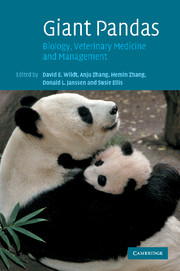Book contents
- Frontmatter
- Contents
- List of contributors
- Foreword
- Acknowledgements
- 1 The giant panda as a social, biological and conservation phenomenon
- 2 The Giant Panda Biomedical Survey: how it began and the value of people working together across cultures and disciplines
- 3 Factors limiting reproductive success in the giant panda as revealed by a Biomedical Survey
- 4 Significant medical issues and biological reference values for giant pandas from the Biomedical Survey
- 5 Life histories and behavioural traits as predictors of breeding status
- 6 Nutrition and dietary husbandry
- 7 Male reproductive biology in giant pandas in breeding programmes in China
- 8 Endocrinology of the giant panda and application of hormone technology to species management
- 9 The value and significance of vaginal cytology
- 10 Parentage assessment among captive giant pandas in China
- 11 The science of behavioural management: creating biologically relevant living environments in captivity
- 12 Evaluating stress and well-being in the giant panda: a system for monitoring
- 13 The neonatal giant panda: hand-rearing and medical management
- 14 Consequences of early rearing on socialization and social competence of the giant panda
- 15 Medical management of captive adult and geriatric giant pandas
- 16 Diseases and pathology of giant pandas
- 17 Ultrasonography to assess and enhance health and reproduction in the giant panda
- 18 Gastrointestinal endoscopy in the giant panda
- 19 Historical perspective of breeding giant pandas ex situ in China and high priorities for the future
- 20 Role and efficiency of artificial insemination and genome resource banking
- 21 Analysis of demographic and genetic trends for developing a captive breeding masterplan for the giant panda
- 22 Partnerships and capacity building for securing giant pandas ex situ and in situ: how zoos are contributing to conservation
- Index
- Plate Section
- References
8 - Endocrinology of the giant panda and application of hormone technology to species management
Published online by Cambridge University Press: 09 August 2009
- Frontmatter
- Contents
- List of contributors
- Foreword
- Acknowledgements
- 1 The giant panda as a social, biological and conservation phenomenon
- 2 The Giant Panda Biomedical Survey: how it began and the value of people working together across cultures and disciplines
- 3 Factors limiting reproductive success in the giant panda as revealed by a Biomedical Survey
- 4 Significant medical issues and biological reference values for giant pandas from the Biomedical Survey
- 5 Life histories and behavioural traits as predictors of breeding status
- 6 Nutrition and dietary husbandry
- 7 Male reproductive biology in giant pandas in breeding programmes in China
- 8 Endocrinology of the giant panda and application of hormone technology to species management
- 9 The value and significance of vaginal cytology
- 10 Parentage assessment among captive giant pandas in China
- 11 The science of behavioural management: creating biologically relevant living environments in captivity
- 12 Evaluating stress and well-being in the giant panda: a system for monitoring
- 13 The neonatal giant panda: hand-rearing and medical management
- 14 Consequences of early rearing on socialization and social competence of the giant panda
- 15 Medical management of captive adult and geriatric giant pandas
- 16 Diseases and pathology of giant pandas
- 17 Ultrasonography to assess and enhance health and reproduction in the giant panda
- 18 Gastrointestinal endoscopy in the giant panda
- 19 Historical perspective of breeding giant pandas ex situ in China and high priorities for the future
- 20 Role and efficiency of artificial insemination and genome resource banking
- 21 Analysis of demographic and genetic trends for developing a captive breeding masterplan for the giant panda
- 22 Partnerships and capacity building for securing giant pandas ex situ and in situ: how zoos are contributing to conservation
- Index
- Plate Section
- References
Summary
INTRODUCTION
Increasing breeding success in the giant panda requires a better understanding of its complex reproductive biology. We know that the female is typically mono-oestrus during a breeding season which occurs from February to May (within and outside China). Behavioural and physiological changes associated with pro-oestrus and oestrus last one to two weeks, during which the female exhibits proceptive behaviours, such as scent marking, to advertise her sexual receptivity (Lindburg et al., 2001). During the peri-ovulatory interval, receptive behaviours (e.g. tail-up lordotic posture) climax with copulation generally occurring over a one- to three-day interval. Birthing occurs from June to October with a gestation of 85 to 185 days (Zhu et al., 2001). This unusually wide gestation span is due to the phenomenon of delayed implantation, a varied interval before the conceptus implants in the uterus and begins foetal development. The driving force behind implantation in this species is unknown. The giant panda also experiences pseudopregnancy, whereby the female exhibits behavioural, physiological and hormonal changes similar to pregnancy.
Behavioural and physiological cues associated with both pregnancy and pseudopregnancy include decreased appetite, nest-building and cradling behaviours, vulvar swelling and colouration, mammary gland enlargement and lethargy. Additionally, temporal and quantitative progesterone patterns (tracked by assessing urinary hormone by-products and progestins) are indistinguishable between pregnancy and pseudopregnancy. Therefore, no definitive test currently exists for identifying pregnant from pseudopregnant giant pandas.
- Type
- Chapter
- Information
- Giant PandasBiology, Veterinary Medicine and Management, pp. 198 - 230Publisher: Cambridge University PressPrint publication year: 2006
References
- 15
- Cited by



